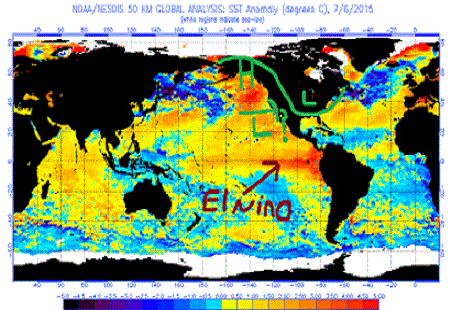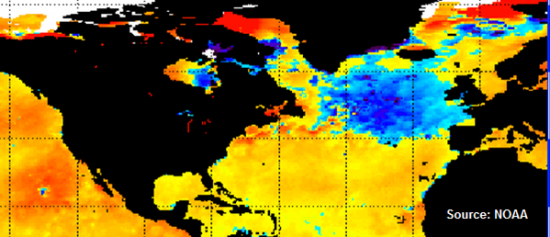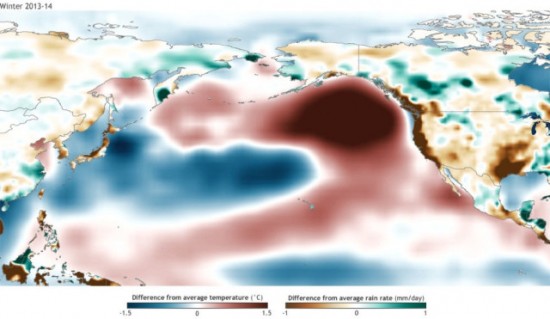January 4, 2016 – At the end of the last Ice Age, an obstructive ice dam in the St. Lawrence River valley breached causing a massive n amount of freshwater to drain out of glacial Lake Agassiz into the North Atlantic Ocean. The study of ice cores from Greenland shows evidence of this sudden influx and how it altered climate in Europe for multiple decades if not centuries causing plunging temperatures at a recurrence of glaciation on the continent. The phenomenon was a cold freshwater blob floating on the Atlantic Ocean’s surface covering the more dense and warmer saltwater beneath. The impact on the North Atlantic’s biodiversity must have been substantial.
The North Atlantic Cold Blob
A recurrence of this phenomenon on a lesser scale is happening in the North Atlantic today. This time the source of colder freshwater isn’t a North American glacial lake. It’s Greenland where the onshore ice masses are melting at a record rate discharging cold freshwater into the adjacent ocean where it is pooling and impacting the movement of water from the Gulf Stream to Europe’s coasts, a phenomenon known as The North Atlantic Drift. The Drift brings warm Gulf of Mexico water to European shores making winters there milder than locales in North America at similar latitudes. To illustrate check out today’s temperatures in St. John’s, Newfoundland which sits at 47 degrees, 37 minutes north with St. Nazaire and Nantes in France approximating the same latitude. The former’s high hit 3 degrees Celsius (37 Fahrenheit). The latter was 9 Celsius (16 Fahrenheit) warmer. Clearly the cold blob seen in blue on the map below has, as yet, to impact St. Nazaire or Nantes this winter, but it may soon if Greenland continues to experience record melts.
The Eastern North Pacific Warm Blob
This winter it isn’t the cold blob that is making the headlines compared to the 2-years’ running warm blob located in the North Pacific as seen in the U.S. National Oceanic and Atmospheric Administration (NOAA) produced map below.
To give you an idea of the extent of this phenomenon, it is a warm patch of ocean approximately the area of Alaska with a depth of 100 meters (330 feet) and temperatures 2.8 degrees Celsius (5 Fahrenheit) warmer than historical average.
What’s the cause?
Likely a change in atmospheric circulation over the North Pacific leading to a persistent high pressure ridge, clear skies and lower wind speeds. The result is a greater exposure of the surface to sunlight whose energy converts from photons to heat when absorbed by the seawater. Climatologists speculate that the thinning of the extent of Arctic summer sea ice correlates directly to the blob’s appearance.
The phenomenon predated the current El Nino by two years and is believed to be partly responsible for California’s current altered climate of prolonged drought.
If there is any good news it is recent observations that the blob may be dissipating. For parched California and the Colorado River basin to the east this may be welcome relief. But not necessarily for long, says climatologists, because climate change is expected to continue to alter atmospheric circulation returning these conditions not once a century but once a decade. That’s not good for California and the Colorado and certainly not good for the biodiversity of the American West and Pacific coast.
El Nino is Not the Blob
But blob or no blob, El Nino, that cyclic event that tends to occur just before Christmas, impacts the equatorial Pacific every few years. In its return this time it is expected to be equal to or more intense than the record event of 1997-98. Every El Nino transfers warm water from the western Pacific to the east. the redistribution of heat ups the surface water off South America’s west coast. It’s not just warmer, it also expands raising sea levels.
The phenomenon wreaks havoc on rainfall patterns because of the heat transfer. Southeast Asia experiences extreme weather events from drought and wildfire outbreaks to massive flooding in Indonesia and South Asia. El Nino events impact the timing of the annual Indian Ocean monsoon by delaying it several weeks.
The warming shift from west to east is also associated with widespread Pacific Ocean coral bleaching, lowering sea levels in the western Pacific and raising them in the east. It is associated with more intense Pacific typhoons.
El Nino events reach even further impacting North America, Europe, and Africa. The 1997-98 El Nino caused extensive rainfall in the United States southeast, and abnormally warm winters throughout much of North America. Abnormal warmth in northern latitudes is not necessarily a good thing. Insect pests that succumb to the cold thrive. The Mountain Pine Beetle and Emerald Ash Borer are two that have enjoyed El Nino’s beneficence.
The current El Nino appears to be even more intense than the one in 1997-98. It may end California’s drought but not necessarily in a good way. The parched soils may be subject to saturating rainfalls leading to mudslides and rapid runoff.
And the World Health Organization and United Nations are gearing up for what will probably be an El Nino induced famine in Africa from the Horn to southern portions of the continent as dramatic drops in precipitation at the outset of the growing season lead to crop failures.
Even ocean life is being impacted. Surveys off California and western South America’s coasts show invasive species occupying domestic species’ habitats and competing for food. One example is California’s sea lions who have experienced changes to their normal food sources forcing them to seek other prey. The combination of Pacific blob and El Nino may duplicate conditions that led last year to a record number of abandoned sea lion pups stranded on Southern California’s shores. Mother sea lions couldn’t find enough to eat to lactate and feed their babies.
Weather and climate change are intersecting. With the El Nino’s impact expected to linger for the next six to nine months the phenomenon appears to be supercharged by a general atmospheric warming over the entire Pacific. The confluence of a warming atmosphere with the repetition of the El Nino phenomenon is taking us into uncharted waters.













